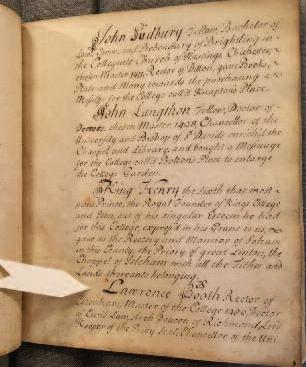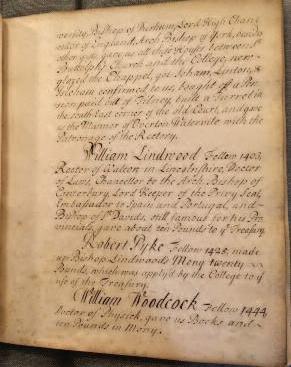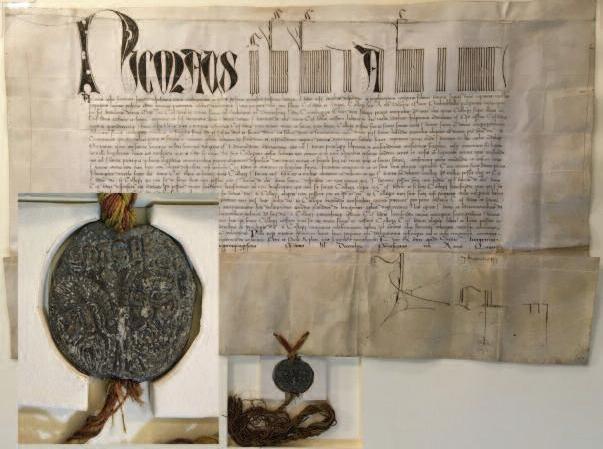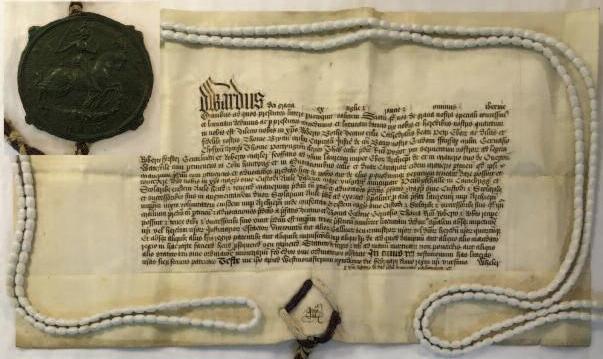
6 minute read
Wartime Propaganda – Archie Williams Commemoration of Benefactors (1): Laurence Booth
Commemoration of Benefactors (1): Laurence Booth
Lizzy Ennion-Smith
Advertisement
In the first of what is hoped to be an occasional series in the Pembroke Gazette focussing on College benefactors, the College Archivist Lizzy Ennion-Smith discusses the impact of Laurence Booth on the College. The College has been fortunate to have a great many benefactors over its centuries of existence. From small gifts to large gifts, each benefactor has contributed to the development of the College into what it is today. As part of the Commemoration of Benefactors Service, I looked at one of our benefactors in more detail: Laurence Booth. Not to be confused with Sir Philip Booth, a 16th century benefactor who gave the College property in London. Laurence appears on the third page of one of our earliest surviving books of benefactors. This particular volume dates from around 1730, based on the date of the last entry in the volume.
Why choose Laurence? He was certainly an interesting character, rising and falling with the fortunes of his patrons, he cemented the College’s links with the North; but he was also named by Bishop Andrewes as the College’s ‘third founder’ so I wanted to find out more.
Booth was born around 1420, the illegitimate son of John Booth of Barton in Eccles, Lancashire. He likely came up to Pembroke in the late 1430s or early 1440s, and took degrees in both civil and canon law by 1448. But prior to this he had received papal dispensation as a son of unmarried parents for promotion to holy orders, and had been duly ordained priest in 1446.
The Pembroke Fellowship clearly saw something in him, electing him Master of Pembroke in 1450. A position he held till his death. He was the first Master who was not a Fellow and his election followed a petition from the Fellowship to the Pope for dispensation from the Statute compelling them to elect a Master from the Fellowship. This desire for a Master not from the Fellowship came from a

wish for the College to have a wider influence, especially at Court. In anticipation of the success of the petition, Laurence had already been elected to succeed Hugh Damlet who had resigned in April 1450. The papal bull for the dispensation is dated November of that year. This document was conserved in 2020 and a close up of the seal, made of lead, shows the papal seal of Pope Nicholas V. The heads of the Apostles Saint Peter and Saint Paul can just about be seen.
Initially a mainly absent Master, firstly as chancellor and keeper of the privy seal for Queen Margaret, better known as Margaret of Anjou, wife of Henry VI, then as Dean of St Paul’s, and from 1457 as Bishop of Durham. But with his fortunes tied to the Lancastrian cause, the Yorkist victory in 1461 at Towton meant a return to College. Matthew Wren found evidence in the College records of commons that in the 1460s Laurence was in residence at the College for long periods.
He returned to favour with the Court by 1473 when he was made Lord Chancellor and in 1476 he became Archbishop of York – that year the College gates were painted – possibly in honour of so great an event.
Laurence died at Southwell in May 1480, perhaps after a long illness, for he drew up his will on 28th September 1479. He was buried alongside his brother in the chantry chapel dedicated to St John the Baptist which he had founded there, and which his executors were to complete. Alas we cannot see his tomb today as it appears it was destroyed by a falling wall in 1847.
So a brief summary of his career has been given, but for members of Pembroke, we are particularly interested in his impact upon the College. As I have said, he was elected Master in 1450 and immediately began to work on behalf of the College. Just a year after his election he obtained for the College the perpetual lease of St Thomas’s Hostel from St John’s Hospital for a yearly rent of six

shillings and eightpence! The length of this plot ran from what is now Trumpington Street to approximately the main entrance to the current library and the width from about halfway through the chapel to the end of the Red Buildings. The Hostel brought more students to the College with 34 noted as in residence by 1457, each paying eightpence a term to the College. A lucrative source of income and influence!
The library over the Hall was also completed during Booth’s Mastership and it may in fact have been Booth who paid for it or obtained donations to pay for it. His donations also enhanced the then Chapel, adding stained glass, and giving stalls, a rood-screen, loft and figures of Saints. It is also said he had saffron planted in the gardens. When a new plaster ceiling was added to the Hall in 1926, Laurence’s arms were incorporated into the design, along with those of other significant benefactors: the Foundress, Henry VI, Archbishop Grindal, Bishop Andrewes, Sir Robert Hitcham, Sergeant William Moses, and Sara Lonsdale. Have a look next time you are in Hall and see if you can spot Laurence’s arms –they feature a bishop’s mitre above the shield. The shield itself is described in heraldic terms as Argent, three boar’s heads erased sable erect, i.e. white with 3black boars heads.
He would also go on to secure property lying between the College and St Botolph’s which gave the College access to a bakery and brewery. This is now the triangle of land between Pembroke Street and Botolph Lane.
Add to this his work to secure earlier gifts from Henry VI of the rectory and advowson of Soham, Linton Priory and a cell at Isleham which could have been lost to the College upon the accession of Edward IV, and Laurence was indeed a significant benefactor.
And a benefactor not just to the College. He held the position of Chancellor of the University for 2 years from 1456 and saw to it that work started on the building of new schools for the public acts and lectures.
Laurence’s gifts to the College were not all so concrete, under him the fame of the College grew and it began to nurture great men: Thomas Langton for example, a Fellow in 1461 went on to be bishop of successively, St David’s, Salisbury and Winchester and became Provost of Queen’s College, Oxford. Richard Stubbs, Fellow from around 1467 became Master of Clare Hall and William Chubbes, Fellow from 1466, became the first Master of Jesus to give just 3 examples.
Laurence’s final act for the College was to bequeath the manor and advowson, or the right to appoint the vicar, of Orton Waterville or Cherry Orton in Huntingdonshire, now a suburb of Peterborough. It was named after the Waterville family who settled there after the Norman Conquest. Much of the land at Orton Waterville was sold off in the 1950s when managing agricultural property became expensive. But the College retains many documents relating to Orton Waterville, including a licence of mortmain for the original transfer of the manor to the College in February 1480. The document includes the seal of Edward IV.

Each of our benefactors have their own stories and I hope I will be able to share some more of these with you in the future.





